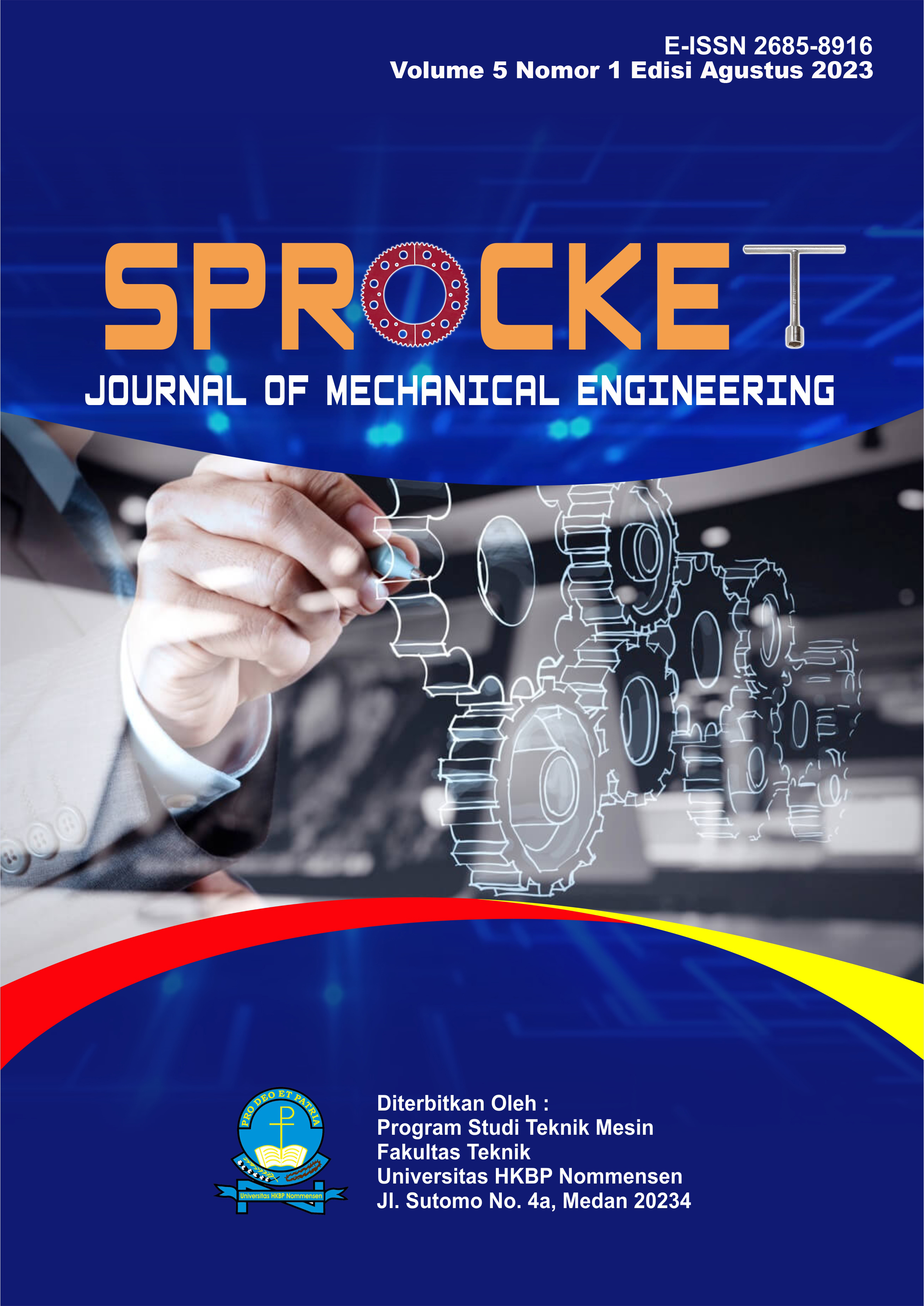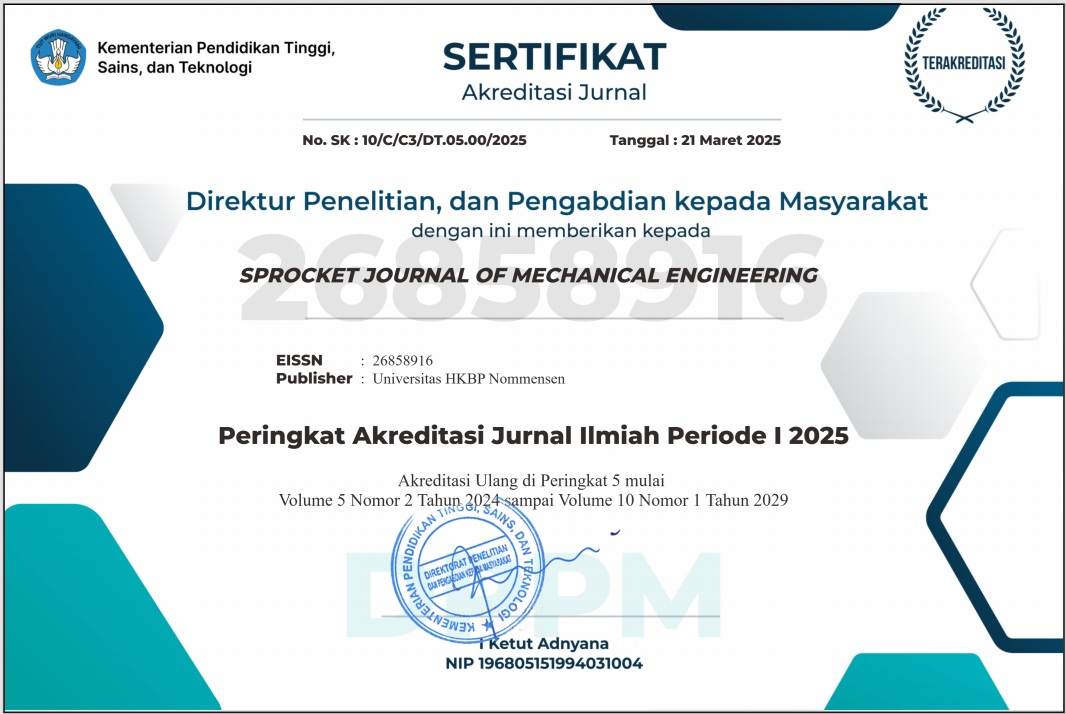Simulasi CFD Distribusi Temperatur pada Pengering Biji Kopi dengan Sistem Konveksi Paksa
Abstract
Drying is a mass transfer and heat transfer process that is strongly influenced by temperature and air velocity. The importance of analyzing the temperature distribution and air velocity is expected to be used as a reference to optimize the drying process to be faster and better. This study aims to analyze the temperature distribution and air velocity that occurs in a coffee bean dryer with a forced convection system using CFD simulation. CFD simulations are carried out using ANSYS Fluent software. with steady conditions, and using a pressure-based solver method. The obtained temperature distribution occurs with an estimated absorber temperature difference with the drying chamber is 31% during the day.
References
[2] P. Siagian, E. Y. Setyawan, T. Gultom, F. H. Napitupulu, and H. Ambarita, “A field survey on coffee beans drying methods of Indonesian small holder farmers,” in IOP Conference Series: Materials Science and Engineering, Institute of Physics Publishing, Sep. 2017. doi: 10.1088/1757-899X/237/1/012037.
[3] ) Parulian Siagian et al., “Analisa Kebutuhan Energi Termal Pada Kotak Pengering Biji Kopi Arabica yang di Isolasi dengan Aluminium Foil,” vol. 4, no. 2, 2023.
[4] H. Ambarita, H. K. J. Munthe, and T. Hutagalung, “Design of a Continuous Coffee Bean Solar Dryer,” in Journal of Physics: Conference Series, Institute of Physics Publishing, Jun. 2020. doi: 10.1088/1742-6596/1542/1/012025.
[5] N. D. M. Romauli and H. Ambarita, “Study on the convective drying of potato cube,” in IOP Conference Series: Earth and Environmental Science, Institute of Physics Publishing, Jun. 2019. doi: 10.1088/1755-1315/260/1/012042.
[6] W. S. Damanik, F. H. Napitupulu, A. H. Nasution, and H. Ambarita, “Energy analysis of double slope aktive solar still,” in IOP Conference Series: Materials Science and Engineering, Institute of Physics Publishing, Jan. 2020. doi: 10.1088/1757-899X/725/1/012007.
[7] A. R. H. Sirait, G. P. Hutapea, and H. Ambarita, “Comparison of 2 angle collectors with variations 0°, 20°, 30° and trapezoidal groove plate,” in Journal of Physics: Conference Series, Institute of Physics Publishing, Jun. 2020. doi: 10.1088/1742-6596/1542/1/012069.
[8] H. Ambarita, R. E. T. Siregar, A. D. Ronowikarto, and E. Y. Setyawan, “Effects of the inclination angle on the performance of flat plate solar collector,” in Journal of Physics: Conference Series, Institute of Physics Publishing, Mar. 2018. doi: 10.1088/1742-6596/978/1/012097.
[9] A. Qadry, T. Hutagalung, K. J. M. Harry, R. A. M. Napitupulu, and H. Ambarita, “Experiemental study on solar dryer with extended flat plate collector,” in IOP Conference Series: Materials Science and Engineering, Institute of Physics Publishing, Jan. 2020. doi: 10.1088/1757-899X/725/1/012018.
[10] S. F. Dina, H. Ambarita, F. H. Napitupulu, and H. Kawai, “Study on effectiveness of continuous solar dryer integrated with desiccant thermal storage for drying cocoa beans,” Case Studies in Thermal Engineering, vol. 5, pp. 32–40, Mar. 2015, doi: 10.1016/j.csite.2014.11.003.
[11] A. Qadry, N. D. M. Romauli, and H. Ambarita, “Study on Experimental of continuous solar dryer with dessicant Cacl2 thermal storage,” in Journal of Physics: Conference Series, Institute of Physics Publishing, Jun. 2020. doi: 10.1088/1742-6596/1542/1/012043.
[12] Himsar Ambarita, Perpindahan Panas Dan Massa : Penyelesaian Analitik Dan Numerik, vol. 1. Malang: Intelegensia Media, 2017.

This work is licensed under a Creative Commons Attribution 4.0 International License.
Penulis yang menerbitkan dengan SPROCKET JOURNAL OF MECHANICAL ENGINEERING menyetujui ketentuan berikut :
- Penulis memegang hak cipta dan memberikan jurnal hak penerbitan pertama dengan karya yang dilisensikan secara bersamaan di bawah Lisensi Internasional Creative Commons Atribusi 4.0 . yang memungkinkan orang lain untuk berbagi karya tersebut dengan pengakuan atas kepengarangan karya dan penerbitan awal dalam jurnal ini.
- Penulis dapat membuat pengaturan kontraktual tambahan yang terpisah untuk distribusi non-eksklusif atas versi jurnal yang diterbitkan dari suatu karya (misalnya, mempostingnya ke repositori institusional atau menerbitkannya dalam sebuah buku), dengan pengakuan atas penerbitan awalnya di jurnal ini.
- Penulis diizinkan dan didorong untuk mengunggah karya mereka secara daring (misalnya, di repositori institusi atau di situs web mereka) sebelum dan selama proses penyerahan, karena hal ini dapat mengarah pada pertukaran yang produktif, serta kutipan yang lebih awal dan lebih banyak dari karya yang diterbitkan (Lihat Pengaruh Akses Terbuka ).






.png)
.png)

